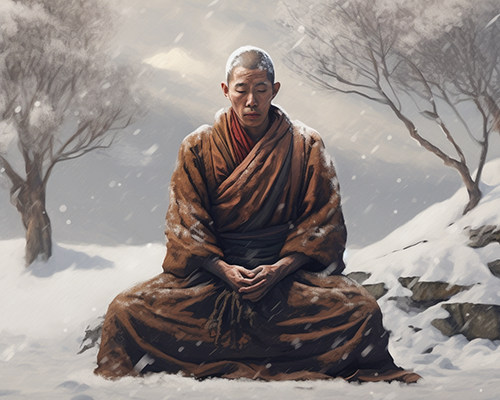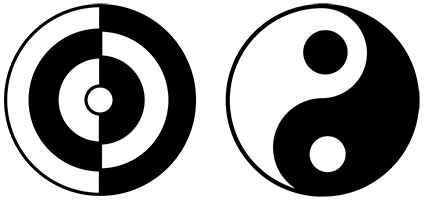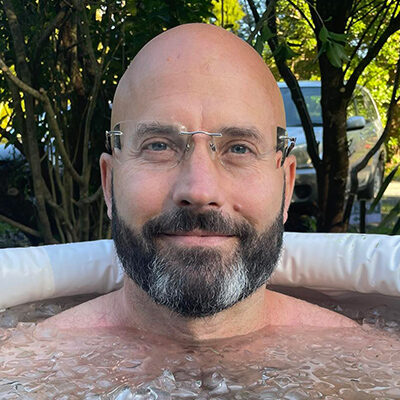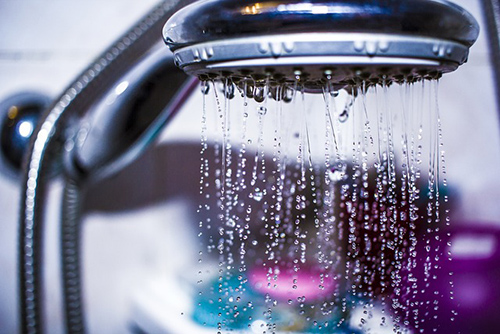
In recent years, exposure to cold through ice baths, cold showers, and winter swimming has had a resurgence in popularity. Almost anyone with an interest in natural ways to improve their health has now heard of, and perhaps even tried some of these practices. This has led to growing curiosity about how cold exposure fits in with the principles and methods of other health practices, including Traditional Chinese Medicine and Qigong.
In this article I will give a brief overview of how cold exposure fits within the context of Chinese Medicine, and insights we can gain from Chinese philosophy to help us to better understand cold exposure practices and how use them in ways that will be most beneficial to us.
Cold Exposure in Cultures Around the World
Ancient cultures all over the world have made use of cold bathing practices in one form or another, from the Egyptians, to the Greeks, the Romans, and in more recent times the Nordic countries with their climates making access to very cold water more readily available than other parts of the world. It is reasonable to assume that if a practice is natural, truly beneficial, and reasonably accessible without the need for specific technology etc, then we will find traces of it in almost every culture around the world as people independently discover the value and benefit of it through their natural curiosity and desire to improve their lives. While not so famous for this practice in modern times, the Chinese culture did not miss out on discovering the benefits of such a simple natural practice, with the ancient Chinese physician Hua To perhaps being the most famous for plunging his patients into troughs of cold water in his garden to invigorate their energy and restore health. The monks of Tibet were also famous for testing their skill with breathing practices by seeing if they could melt the snow around them while sitting outdoors and practicing in winter.

It may surprise some people to learn that the Chinese also used cold water bathing and other cold exposure practices for health. They may be familiar with practices from Chinese medicine such as always heating water up before drinking it and avoiding going barefoot to protect against cold. With such a strong focus on keeping the body warm both internally and externally for health, it may seem strange and even contradictory to also discover that within the same philosophical system there are also practices which focus on intentional exposure to cold for improving health. Taking a step backwards to understand the broad underlying philosophy can help us to reconcile these seeming contradictions and understand the context around when one approach might be more useful to us than another, so that we can apply any specific practices with wisdom and gain the most benefit from them.
Cold Exposure and Chinese Philosophy (Taiji and Yin and Yang)
The main part of Chinese philosophy that will help us to understand the most beneficial application of practices that work with cold (and hot) is the philosophy of Taiji, or Yin and Yang.
Taiji is the philosophy of polarity, an understanding of the inherent necessity of the existence of opposites across every facet of life, and how the interaction between these opposites naturally brings dynamic flow, circulation, and life! One of these poles is known as Yin, and includes qualities such as low, dark, internal, slow, and cold! The other pole is known as Yang, and includes qualities such as high, light, external, fast, and hot!
The principle of Taiji, or the interplay of yin and yang has been depicted in various ways over the years. The images below show two diagrams which draw out different qualities of yin and yang:

The image on the left is a more ancient depiction and draws out the idea that there are layers of yin and yang which always complement and balance each other, and the image on the right draws out the dynamic interplay between yin and yang. When yin has developed sufficiently it converts into yang, and when yang has developed enough it converts into yin, and within both yin and yang can always be found the seed of the other. When yin and yang are in harmony they feed into each other, strengthening one another and creating overall flow and vitality.
With this basic understanding of yin and yang and taiji, we can better understand the effect that cold or heat exposure has on our body and energy.
Yin and Yang Effects of Cold and Heat
Cold is yin, and therefore exposure to it has a direct yin effect on our body. It will cool our body down and cause our energy to move inwards towards our centre. It may also cause us to slow down. But there is a counterpoint to this, within the yin of the cold exposure there is the seed of yang. Our body will seek to counterbalance the cold it is exposed to by becoming more yang, generating more heat, sending energy back outwards to the surface, and becoming more active. So while there is an immediate yin effect from the cold exposure, it also stimulates the yang, and a relatively short exposure to cold can stimulate our body to keep itself warmer more effectively throughout the rest of the day, strengthen the energy at the surface of our body which boosts our immunity, and leave us feeling more active and vital.
Heat is yang, and therefore exposure to it has a direct yang effect on our body. It will heat our body up and cause our energy to move outwards towards the surface. It will also speed up the rate of activity in all the cells of our body. The counterpoint to this is that our body will seek to counterbalance the yang of the heat by becoming more yin, releasing excess stored energy so that it can cool itself more effectively, and afterwards entering a state of deeper relaxation, drawing energy back to the centre.
Cold and Heat Exposure as Exercise
Understanding not just the direct effect of heating or cooling, but the way our body and energy dynamically responds to these stimuli helps us to understand the many benefits that can come from cold (and heat) exposure. We can think of the cold or heat as a force that our body needs to exert effort against, in much the same way that lifting a weight or going for a run requires effort. When we expose our body to cold or heat we are making it work, and when we do this regularly it gets better at doing that work – like getting stronger at lifting weights or faster at running. Each time we expose ourselves to heat or cold we are exercising our body’s ability to respond to that stimulus. Its ability to open or close the pores of our skin, its ability to dilate or constrict our blood vessels and send energy to the surface of our body, or draw it back to our centre.
By alternating between stimuli, yin and yang, we perform multiple repetitions of exercising these capabilities of our body, making them fitter and stronger, and better able to circulate our energy in whatever way we need it to maintain our health and wellbeing. Yin and yang flowing into one another create movement and vitality. This is why many practices involve not just exposure to cold or heat, but alternating between these two, opening and closing, dilating and constricting the tissues of our body.
Finding the Right Level of Exertion/Exposure
There is real exertion involved in responding to these stimuli though, and as with any exercise it is important to gauge our current level of fitness and strength to choose a suitable level of exertion for ourselves. Just as you may injure yourself by trying to lift a weight that is too heavy for your current level of strength, exposing yourself to cold or heat that is beyond your body’s current level of ability to regulate itself may be detrimental rather than beneficial. Fortunately, just as when exercising by lifting weights you can choose to use a lighter weight when needed and gradually progress to heavier weights as we get stronger, we can find ways to apply these principles of cold and heat exposure and get the benefit of them no matter what our current level of health and fitness is.
When people think of cold exposure, they often immediately think of sitting in a bathtub filled with ice water, or diving through a hole in a frozen lake, and for heat exposure they might think of sitting for long periods of time in a hot sauna or sweat lodge. For most people these rather extreme forms of cold and heat exposure will be fine for them to do, and the main way to match these to their current level of health and fitness will be to adjust the amount of time they spend in these very cold or very warm environments.

A good way to see if you have got the level of stimulus right is by seeing how your body and energy responds after the stimulus. When you get it right – following an ice bath, after an initial period of perhaps feeling a bit cold, you will then actually feel warmer throughout the rest of the day because your body is strong enough that it has been able to respond to the cold stimulus positively. On the other hand, if several hours later you are still feeling cold, you have probably done more than your body is able to cope with well right now. Rather than finding the seed of yang within the yin, your body has become overwhelmed by the yin and it is probably wise to use a more gentle stimulus next time, spending less time in the cold until you find your body reacting positively with yang and warmth afterwards. You can then start to build up the amount of time you spend in the cold as your body and energy gets stronger.
For heat exposure – if you are still feeling hot or agitated an hour or so afterwards, again this has probably been too strong of a stimulus for you, and you should spend less time next time. It is healthy to feel comfortably warm for an extended period afterwards, but any excess heat should dissipate quickly and leave a general sense of relaxation and wellbeing if your body is responding positively to the yang stimulus with a yin relaxation response.
Gentler Forms of Cold and Heat Exposure
Some people may need to use even gentler forms of cold and heat exposure than can be achieved by just spending less time in an ice bath or sauna. They may need the intensity of the cold and the heat to be less extreme in the first place. Also, we don’t necessarily need to always be exercising at our maximum capacity. Just as we don’t always need to sprint as fast as we can to get some healthy exercise, gentler forms of cold and heat exposure are also healthy and beneficial for us in the same way that going for a walk is healthy for us sometimes instead of always running.

One gentler way to give yourself this alternating yin and yang stimulus is to simply use the water from your shower, and switch it from hot to cold and back again several times while you shower. This is a simple way to give your circulatory system a gentle workout, and be even more invigorated by your shower than you usually would be. If you want to leave the shower feeling energized – finish with cold water as this will mean you finish with your body responding with yang. If you want to leave the shower feeling more relaxed – finish with warm water as this will mean you finish with your body responding with yin.
For people with very fragile health, even hot and cold showers might be a bit too strong of a stimulus for them. These are the same people who should take extra care to warm their water before drinking it, and to avoid going bare foot so that they can keep their feet warm. Still even people in this situation can benefit from the alternating yin and yang stimulus of cold and heat exposure to invigorate their energy and improve their circulation, but they need to do it very gently. One very gentle way this can be done is by using foot baths. By heating or cooling just the extremities of the body, the overall level of exertion required from the whole body is much less. The heat on the feet gradually causes the blood vessels to dilate as the warm spreads to the rest of the body. The cold on the feet gradually causes the blood vessels throughout the body to constrict gently. Alternating between cold and hot several times can provide a gentle workout for the circulatory system without straining an already weak system, benefiting not just the feet but the circulation to the whole body. Over time this can lead to improved health and strength until stronger stimulus can be used.
Conclusion
I hope you have enjoyed this brief overview of how the increasingly popular practice of cold exposure fits within the context of Chinese philosophy and practice. We can sometimes become very focused on just a few ways that we can work with our body and energy to create health, and not realize how many different tools and practices there are that we can make use of.
There are so many useful ways we can work with our energy to bring balance and vitality, and perhaps this will inspire you to try out cold and heat exposure alongside other practices such as qigong that you may currently do, and see the effect it has on your energy and overall health and wellbeing.
If you have heard about cold exposure and thought that maybe it was too extreme of a practice for you to try, perhaps this article will have given you some insight into how you can apply it in a way that will be suitable for you, whatever your current level of health and fitness may be.
1 Comment. Leave new
Can you give me the source about the cold water therapy Hua Tuo used with his patients? I can’t find it anywhere! Thank you so much. Warm regards, Liselotte